Adsorption Evaluation for the Removal of Nickel, Mercury, and Barium Ions from Single-Component and Mixtures of Aqueous Solutions by Using an Optimized Biobased Chitosan Derivative
Abstract
1. Introduction
2. Materials and Methods
2.1. Materials
2.2. Synthesis of CS-HMF Adsorbent
2.3. Characterization Techniques
2.4. Adsorption Process
2.4.1. pH Effect
2.4.2. Contact Time Effect
2.4.3. Isotherms
2.4.4. Mixtures
3. Results and Discussion
3.1. SEM and FTIR
3.2. Adsorption Evaluation—Single-Component Solutions
3.2.1. pH Effect
3.2.2. Contact Time Effect
3.2.3. Effect of Initial Concentration/Temperature on Equilibrium
Thermodynamic Estimation
3.3. Adsorption Evaluation—Mixtures
3.4. Comparisons
4. Conclusions
Author Contributions
Funding
Institutional Review Board Statement
Informed Consent Statement
Data Availability Statement
Conflicts of Interest
References
- Ali, A.; Ing, A.W.C.; Abdullah, W.R.W.; Hamzah, S.; Azaman, F. Preparation of High-Performance Adsorbent from Low-Cost Agricultural Waste (Peanut Husk) Using Full Factorial Design: Application to Dye Removal. Biointerface Res. Appl. Chem. 2020, 10, 6619–6628. [Google Scholar]
- Ali, S.F.A.; Gad, E.S. Investigation of an adsorbent based on novel starch/chitosan nanocomposite in extraction of indigo carmine dye from aqueous solutions. Biointerface Res. Appl. Chem. 2020, 10, 5556–5563. [Google Scholar]
- Batool, M.; Khurshid, S.; Qureshi, Z.M.; Daoush, W.M.; Hashmi, F.; Mehboob, N. Effective adsorptive removal of azodyes on synthesized copper oxide nanoparticles. Biointerface Res. Appl. Chem. 2020, 10, 53695375. [Google Scholar]
- Cotrim, A.C.M.; França, E.L.; França, A.C.H.; Martins, J.S.; Silva, K.P.G.; Ghalfi, Y.C.; Machado, I.T.; Tozetti, I.A. Effect of polyethylene glycol microspheres adsorbed with melatonin on oxidative stress and viscosity of cervical mucus samples infected with human papillomavirus. Biointerface Res. Appl. Chem. 2020, 10, 6757–6772. [Google Scholar]
- Kulkarni, S. Synthesis, characterization and performance of low-cost unconventional adsorbents derived from waste materials. Biointerface Res. Appl. Chem. 2020, 10, 7243–7256. [Google Scholar]
- Crini, G. Recent developments in polysaccharide-based materials used as adsorbents in wastewater treatment. Prog. Polym. Sci. 2005, 30, 38–70. [Google Scholar] [CrossRef]
- Monier, M.; Ayad, D.; Wei, Y.; Sarhan, A. Adsorption of Cu(II), Co(II), and Ni(II) ions by modified magnetic chitosan chelating resin. J. Hazard. Mater. 2010, 177, 962–970. [Google Scholar] [CrossRef]
- Wadi, V.S.; Mittal, H.; Fosso-Kankeu, E.; Jena, K.K.; Alhassan, S.M. Mercury removal by porous sulfur copolymers: Adsorption isotherm and kinetics studies. Colloids Surf. A: Physicochem. Eng. Asp. 2020, 606, 125333. [Google Scholar] [CrossRef]
- Zhang, D.; Crini, G.; Lichtfouse, E.; Rhimi, B.; Wang, C. Removal of Mercury Ions from Aqueous Solutions by Crosslinked Chitosan-based Adsorbents: A Mini Review. Chem. Rec. 2020, 20, 1220–1234. [Google Scholar] [CrossRef]
- Farooq, U.; Kozinski, J.A.; Khan, M.A.; Athar, M. Biosorption of heavy metal ions using wheat based biosorbents—A review of the recent literature. Bioresour. Technol. 2010, 101, 5043–5053. [Google Scholar] [CrossRef]
- Vijaya, Y.; Popuri, S.R.; Boddu, V.M.; Krishnaiah, A. Modified chitosan and calcium alginate biopolymer sorbents for removal of nickel (II) through adsorption. Carbohydr. Polym. 2008, 72, 261–271. [Google Scholar] [CrossRef]
- Tran, H.V.; Tran, L.D.; Nguyen, T.N. Preparation of chitosan/magnetite composite beads and their application for removal of Pb(II) and Ni(II) from aqueous solution. Mater. Sci. Eng. C 2010, 30, 304–310. [Google Scholar] [CrossRef] [PubMed]
- Torab-Mostaedi, M.; Ghaemi, A.; Ghassabzadeh, H.; Ghannadi-Maragheh, M. Removal of strontium and barium from aqueous solutions by adsorption onto expanded perlite. Can. J. Chem. Eng. 2011, 89, 1247–1254. [Google Scholar] [CrossRef]
- Abdulkhair, B.; Salih, M.; Modwi, A.; Adam, F.; Elamin, N.; Seydou, M.; Rahali, S. Adsorption behavior of barium ions onto ZnO surfaces: Experiments associated with DFT calculations. J. Mol. Struct. 2021, 1223, 128991. [Google Scholar] [CrossRef]
- Baldermann, A.; Grießbacher, A.C.; Baldermann, C.; Purgstaller, B.; Letofsky-Papst, I.; Kaufhold, S.; Dietzel, M. Removal of Barium, Cobalt, Strontium, and Zinc from Solution by Natural and Synthetic Allophane Adsorbents. Geoscience 2018, 8, 309. [Google Scholar] [CrossRef]
- Zhou, L.; Wang, Y.; Liu, Z.; Huang, Q. Characteristics of equilibrium, kinetics studies for adsorption of Hg(II), Cu(II), and Ni(II) ions by thiourea-modified magnetic chitosan microspheres. J. Hazard. Mater. 2009, 161, 995–1002. [Google Scholar] [CrossRef]
- Dąbrowski, A.; Hubicki, Z.; Podkościelny, P.; Robens, E. Selective removal of the heavy metal ions from waters and industrial wastewaters by ion-exchange method. Chemosphere 2004, 56, 91–106. [Google Scholar] [CrossRef]
- Blanchard, G.; Maunaye, M.; Martin, G. Removal of heavy metals from waters by means of natural zeolites. Water Res. 1984, 18, 1501–1507. [Google Scholar] [CrossRef]
- Chen, S.; Zhao, W. Adsorption of Pb2+ from Aqueous Solutions Using Novel Functionalized Corncobs via Atom Transfer Radical Polymerization. Polymers 2019, 11, 1715. [Google Scholar] [CrossRef]
- Pham, T.D.; Vu, T.N.; Nguyen, H.L.; Le, P.H.P.; Hoang, T.S. Adsorptive Removal of Antibiotic Ciprofloxacin from Aqueous Solution Using Protein-Modified Nanosilica. Polymers 2020, 12, 57. [Google Scholar] [CrossRef]
- Ahmad, A.; Jamil, S.N.A.M.; Choong, T.S.; Abdullah, A.H.; Mastuli, M.S.; Othman, N.; Jiman, N. Green Flexible Polyurethane Foam as a Potent Support for Fe-Si Adsorbent. Polymers 2019, 11, 2011. [Google Scholar] [CrossRef] [PubMed]
- Maponya, T.C.; Ramohlola, K.E.; Kera, N.H.; Modibane, K.D.; Maity, A.; Katata-Seru, L.; Hato, M.J. Influence of Magnetic Nanoparticles on Modified Polypyrrole/m-Phenylediamine for Adsorption of Cr(VI) from Aqueous Solution. Polymers 2020, 12, 679. [Google Scholar] [CrossRef] [PubMed]
- Ren, L.; Yang, Z.; Huang, L.; He, Y.; Wang, H.; Zhang, L. Macroscopic Poly Schiff Base-Coated Bacteria Cellulose with High Adsorption Performance. Polymers 2020, 12, 714. [Google Scholar] [CrossRef] [PubMed]
- Shaipulizan, N.S.; Jamil, S.N.A.M.; Kamaruzaman, S.; Subri, N.N.S.; Adeyi, A.A.; Abdullah, A.H.; Abdullah, L.C. Preparation of Ethylene Glycol Dimethacrylate (EGDMA)-Based Terpolymer as Potential Sorbents for Pharmaceuticals Adsorption. Polymers 2020, 12, 423. [Google Scholar] [CrossRef] [PubMed]
- Khan, M.A.; Momina; Siddiqui, M.R.; Otero, M.; Alshareef, S.A.; Rafatullah, M. Removal of Rhodamine B from Water Using a Solvent Impregnated Polymeric Dowex 5WX8 Resin: Statistical Optimization and Batch Adsorption Studies. Polymers 2020, 12, 500. [Google Scholar] [CrossRef] [PubMed]
- Sudre, G.; Siband, E.; Gallas, B.; Cousin, F.; Hourdet, D.; Tran, Y. Responsive Adsorption of N-Isopropylacrylamide Based Copolymers on Polymer Brushes. Polymers 2020, 12, 153. [Google Scholar] [CrossRef]
- Zhang, W.; Yang, Z.-Y.; Cheng, X.-W.; Chen, G.; Qiao, Y.-F. Adsorption, Antibacterial and Antioxidant Properties of Tannic Acid on Silk Fiber. Polymers 2019, 11, 970. [Google Scholar] [CrossRef]
- Guo, W.; Xia, T.; Pei, M.; Du, Y.; Wang, L. Bentonite Modified by Allylamine Polymer for Adsorption of Amido Black 10B. Polymers 2019, 11, 502. [Google Scholar] [CrossRef]
- Kim, S.W.; Sohn, J.S.; Kim, H.K.; Ryu, Y.; Cha, S.W. Effects of Gas Adsorption on the Mechanical Properties of Amorphous Polymer. Polymers 2019, 11, 817. [Google Scholar] [CrossRef]
- Wang, C.; Zhao, J.; Wang, S.; Zhang, L.; Zhang, B. Efficient and Selective Adsorption of Gold Ions from Wastewater with Polyaniline Modified by Trimethyl Phosphate: Adsorption Mechanism and Application. Polymers 2019, 11, 652. [Google Scholar] [CrossRef]
- Huang, W.; Diao, K.; Tan, X.; Lei, F.; Jiang, J.; Goodman, B.A.; Ma, Y.; Liu, S. Mechanisms of Adsorption of Heavy Metal Cations from Waters by an Amino Bio-Based Resin Derived from Rosin. Polymers 2019, 11, 969. [Google Scholar] [CrossRef] [PubMed]
- Kong, W.-Q.; Chang, M.; Zhang, C.; Liu, X.; He, B.; Ren, J. Preparation of Xylan-g-/P(AA-co-AM)/GO Nanocomposite Hydrogel and its Adsorption for Heavy Metal Ions. Polymers 2019, 11, 621. [Google Scholar] [CrossRef] [PubMed]
- Sims, R.A.; Harmer, S.L.; Quinton, J.S. The Role of Physisorption and Chemisorption in the Oscillatory Adsorption of Organosilanes on Aluminium Oxide. Polymers 2019, 11, 410. [Google Scholar] [CrossRef] [PubMed]
- Othman, N.A.F.; Selambakkannu, S.; Abdullah, T.A.T.; Hoshina, H.; Sattayaporn, S.; Seko, N. Selectivity of Copper by Amine-Based Ion Recognition Polymer Adsorbent with Different Aliphatic Amines. Polymers 2019, 11, 1994. [Google Scholar] [CrossRef]
- Acharya, R.; Parida, K. A review on adsorptive remediation of Cr(Vi) by magnetic iron oxides and their modified forms. Biointerface Res. Appl. Chem. 2020, 10, 5266–5272. [Google Scholar]
- Anuar, F.I.; Hadibarata, T.; Syafrudin, M.; Fona, Z. Removal of procion red MX-5B from aqueous solution by adsorption on parkia speciosa (Stink bean) peel powder. Biointerface Res. Appl. Chem. 2020, 10, 4774–4779. [Google Scholar]
- Kanthasamy, S.; Hadibarata, T.; Hidayat, T.; Alamri, S.A.; Al-Ghamdi, A.A. Adsorption of azo and anthraquinone dye by using watermelon peel powder and corn peel powder: Equilibrium and kinetic studies. Biointerface Res. Appl. Chem. 2020, 10, 4706–4713. [Google Scholar]
- Lau, K.B.K.; Hadibarata, T.; Elwina, E.; Dewi, R.; Alsahli, A.A.; Alaraidh, I.A.; Al-Ghamdi, A.A. Reactive dyes adsorption via citrus hystrix peel powder and zea mays cob powder: Characterization, isotherm and kinetic studies. Biointerface Res. App. Chem. 2020, 10, 4803–4810. [Google Scholar]
- Satti, Z.; Akhtar, M.; Mazhar, N.; Khan, S.U.; Ahmed, N.; Yasir, Q.M.; Irshad, M.; Pervaiz, R.; Ahmad, W. Adsorption of cadmium from aqueous solution onto untreated gypsum rock material: Equilibrium and kinetics. Biointerface Res. Appl. Chem. 2020, 11, 10755–10764. [Google Scholar]
- Ngah, W.W.; Teong, L.; Hanafiah, M. Adsorption of dyes and heavy metal ions by chitosan composites: A review. Carbohydr. Polym. 2011, 83, 1446–1456. [Google Scholar] [CrossRef]
- Asandei, D.; Bulgariu, L.; Bobu, E. Lead (II) removal from aqueous solutions by adsorption onto chitosan. Cellul. Chem. Technol. 2009, 43, 211–216. [Google Scholar]
- Liakos, E.V.; Mitkidou, S.A.; Mitropoulos, A.C.; Kyzas, G.Z. Nanohybrid chitosans in sorption technology. In Composite Nanoadsorbents; Elsevier: Oxford, UK, 2018; pp. 67–84. [Google Scholar]
- Mone, M.; Lambropoulou, D.A.; Bikiaris, D.N.; Kyzas, G. Chitosan grafted with biobased 5-hydroxymethyl-furfural as adsorbent for copper and cadmium ions removal. Polymers 2020, 12, 1173. [Google Scholar] [CrossRef] [PubMed]
- Siafaka, P.I.; Mone, M.; Koliakou, I.G.; Kyzas, G.Z.; Bikiaris, D. Synthesis and physicochemical properties of a new biocompatible chitosan grafted with 5-hydroxymethylfurfural. J. Mol. Liq. 2016, 222, 268–271. [Google Scholar] [CrossRef]
- Elouear, Z.; Bouzid, J.; Boujelben, N.; Feki, M.; Jamoussi, F.; Montiel, A. Heavy metal removal from aqueous solutions by activated phosphate rock. J. Hazard. Mater. 2008, 156, 412–420. [Google Scholar] [CrossRef]
- Lagergren, S. About the theory of so-called adsorption of soluble substances. Handlingar 1898, 24, 451–465. [Google Scholar]
- Ho, Y.-S.; McKay, G. Pseudo-second order model for sorption processes. Process. Biochem. 1999, 34, 451–465. [Google Scholar] [CrossRef]
- Ho, Y.-S. Review of second-order models for adsorption systems. J. Hazard. Mater. 2006, 136, 681–689. [Google Scholar] [CrossRef]
- Ho, Y.-S. Second-order kinetic model for the sorption of cadmium onto tree fern: A comparison of linear and non-linear methods. Water Res. 2006, 40, 119–125. [Google Scholar] [CrossRef]
- Langmuir, I. The adsorption of gases on plane surfaces of glass, mica and platinum. J. Am. Chem. Soc. 1918, 40, 1361–1403. [Google Scholar] [CrossRef]
- Freundlich, H.F. Over the adsorption in solution. J. Physicochem. 1906, 57, 385. [Google Scholar]
- Mohamed, E.A.; Mobarak, M.; Kumar, R.; Barakat, M.; Bonilla-Petriciolet, A.; Seliem, M.K.; Selim, A.Q. Novel hybrid multifunctional composite of chitosan and altered basalt for barium adsorption: Experimental and theoretical studies. Colloids Surf. A Physicochem. Eng. Asp. 2020, 593, 124613. [Google Scholar] [CrossRef]
- Popuri, S.R.; Vijaya, Y.; Boddu, V.M.; Krishnaiah, A. Adsorptive removal of copper and nickel ions from water using chitosan coated PVC beads. Bioresour. Technol. 2009, 100, 194–199. [Google Scholar] [CrossRef] [PubMed]
- Shafaei, A.; Ashtiani, F.Z.; Kaghazchi, T. Equilibrium studies of the sorption of Hg(II) ions onto chitosan. Chem. Eng. J. 2007, 133, 311–316. [Google Scholar] [CrossRef]
- Li, N.; Bai, R.; Liu, C. Enhanced and Selective Adsorption of Mercury Ions on Chitosan Beads Grafted with Polyacrylamide via Surface-Initiated Atom Transfer Radical Polymerization. Langmuir 2005, 21, 11780–11787. [Google Scholar] [CrossRef]
- Stanley-Wood, N.; Chatterjee, A. The comparison of the surface area of porous and non-porous solids as determined by diffusional flow and nitrogen adsorption. Powder Technol. 1974, 9, 7–13. [Google Scholar] [CrossRef]
- Rinaudo, M. Chitin and chitosan: Properties and applications. Prog. Polym. Sci. 2006, 31, 603–632. [Google Scholar] [CrossRef]
- Ho, Y.-S.; Ofomaja, E.A. Pseudo-second-order model for lead ion sorption from aqueous solutions onto palm kernel fiber. J. Hazard. Mater. 2006, 129, 137–142. [Google Scholar] [CrossRef]
- Wilke, C.R.; Chang, P. Correlation of diffusion coefficients in dilute solutions. AIChE J. 1955, 1, 264–270. [Google Scholar] [CrossRef]
- Daugherty, R.L.; Franzini, J.B. Fluid Mechanics with Engineering Applications, 7th ed.; McGraw–Hill: New York, NY, USA, 1977. [Google Scholar]
- Kyzas, G.Z.; Lazaridis, N.K.; Mitropoulos, A.C. Removal of dyes from aqueous solutions with untreated coffee residues as potential low-cost adsorbents: Equilibrium, reuse and thermodynamic approach. Chem. Eng. J. 2012, 189–190, 148–159. [Google Scholar] [CrossRef]
- Ghiorghita, C.-A.; Borchert, K.B.; Vasiliu, A.-L.; Zaharia, M.-M.; Schwarz, D.; Mihai, M. Porous thiourea-grafted-chitosan hydrogels: Synthesis and sorption of toxic metal ions from contaminated waters. Colloids Surfaces A Physicochem. Eng. Asp. 2020, 607, 125504. [Google Scholar] [CrossRef]
- Le, V.T.; Dao, M.U.; Le, H.S.; Tran, D.L.; Doan, V.D.; Nguyen, H.T. Adsorption of Ni(II) ions by magnetic activated carbon/chitosan beads prepared from spent coffee grounds, shrimp shells and green tea extract. Environ. Technol. 2020, 41, 2817–2832. [Google Scholar] [CrossRef] [PubMed]
- Surgutskaia, N.S.; Di Martino, A.; Zednik, J.; Ozaltin, K.; Lovecká, L.; Bergerová, E.D.; Kimmer, D.; Svoboda, J.; Sedlarik, V. Efficient Cu2+, Pb2+ and Ni2+ ion removal from wastewater using electrospun DTPA-modified chitosan/polyethylene oxide nanofibers. Sep. Purif. Technol. 2020, 247, 116914. [Google Scholar] [CrossRef]
- Chen, A.-H.; Yang, C.-Y.; Chen, C.-Y. The chemically crosslinked metal-complexed chitosans for comparative adsorptions of Cu(II), Zn(II), Ni(II) and Pb(II) ions in aqueous medium. J. Hazard. Mater. 2009, 163, 1068–1075. [Google Scholar] [CrossRef] [PubMed]
- Repo, E.; Warchol, J.K.; Kurniawan, T.A.; Sillanpää, M.E. Adsorption of Co(II) and Ni(II) by EDTA- and/or DTPA-modified chitosan: Kinetic and equilibrium modeling. Chem. Eng. J. 2010, 161, 73–82. [Google Scholar] [CrossRef]
- Heidari, A.; Younesi, H.; Mehraban, Z.; Heikkinen, H. Selective adsorption of Pb(II), Cd(II), and Ni(II) ions from aqueous solution using chitosan–MAA nanoparticles. Int. J. Biol. Macromol. 2013, 61, 251–263. [Google Scholar] [CrossRef]
- Monier, M.; Abdel-Latif, D. Preparation of cross-linked magnetic chitosan-phenylthiourea resin for adsorption of Hg(II), Cd(II) and Zn(II) ions from aqueous solutions. J. Hazard. Mater. 2012, 209, 240–249. [Google Scholar] [CrossRef]
- Monier, M. Adsorption of Hg2+, Cu2+ and Zn2+ ions from aqueous solution using formaldehyde cross-linked modified chitosan–thioglyceraldehyde Schiff’s base. Int. J. Biol. Macromol. 2012, 50, 773–781. [Google Scholar] [CrossRef]
- Ahmad, M.; Manzoor, K.; Chaudhuri, R.R.; Ikram, S. Thiocarbohydrazide Cross-Linked Oxidized Chitosan and Poly(vinyl alcohol): A Green Framework as Efficient Cu(II), Pb(II), and Hg(II) Adsorbent. J. Chem. Eng. Data 2017, 62, 2044–2055. [Google Scholar] [CrossRef]
- Miretzky, P.; Cirelli, A.F. Hg(II) removal from water by chitosan and chitosan derivatives: A review. J. Hazard. Mater. 2009, 167, 10–23. [Google Scholar] [CrossRef]
- Ghaemi, A.; Torab-Mostaedi, M.; Ghannadi-Maragheh, M. Characterizations of strontium(II) and barium(II) adsorption from aqueous solutions using dolomite powder. J. Hazard. Mater. 2011, 190, 916–921. [Google Scholar] [CrossRef] [PubMed]
- Doskočil, L.; Pekař, M. Removal of metal ions from multi-component mixture using natural lignite. Fuel Process. Technol. 2012, 101, 29–34. [Google Scholar] [CrossRef]
- He, K.; Chen, Y.; Tang, Z.; Hu, Y. Removal of heavy metal ions from aqueous solution by zeolite synthesized from fly ash. Environ. Sci. Pollut. Res. 2015, 23, 2778–2788. [Google Scholar] [CrossRef] [PubMed]
- Afkhami, A.; Saber-Tehrani, M.; Bagheri, H. Simultaneous removal of heavy-metal ions in wastewater samples using nano-alumina modified with 2,4-dinitrophenylhydrazine. J. Hazard. Mater. 2010, 181, 836–844. [Google Scholar] [CrossRef] [PubMed]
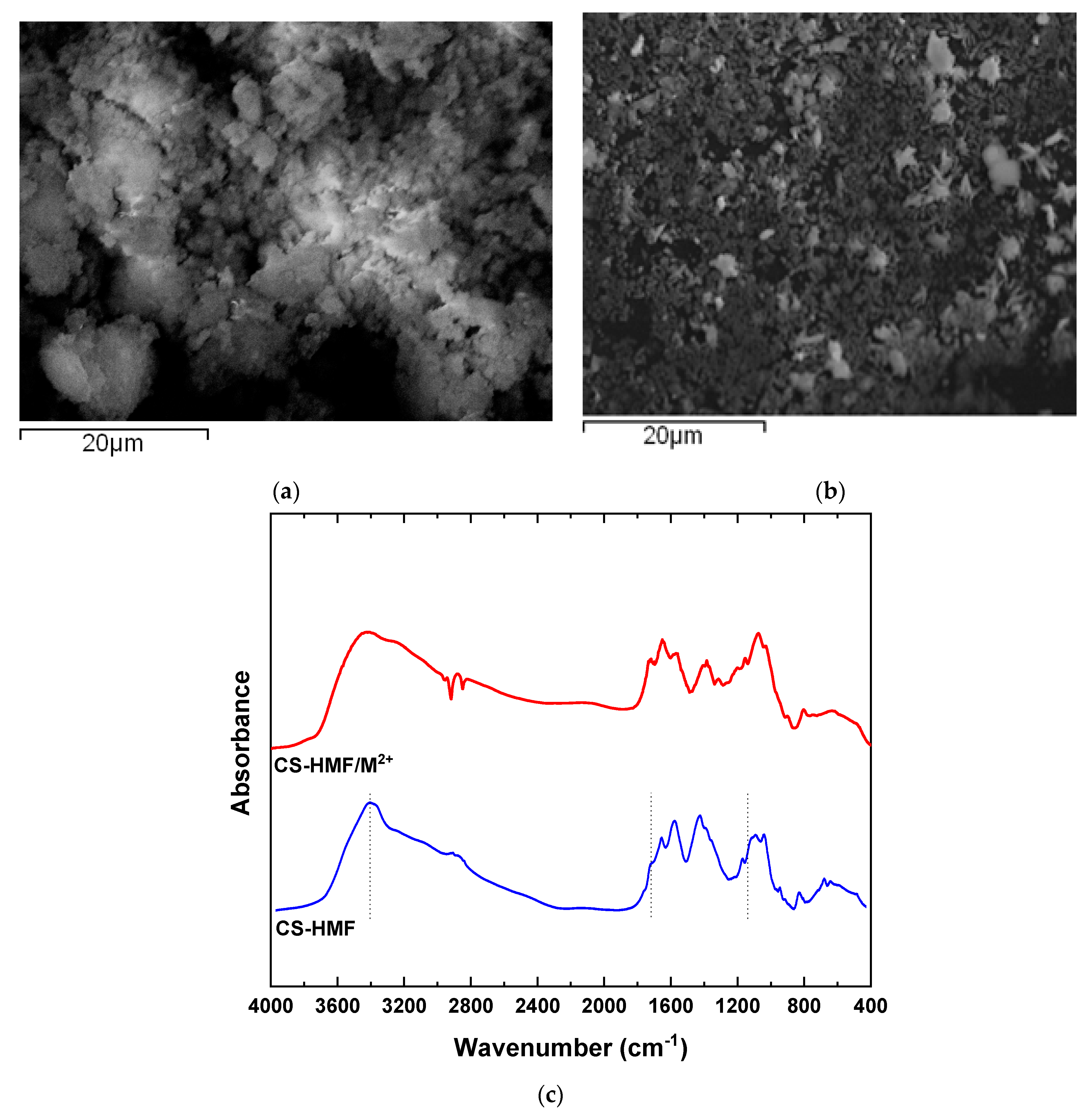

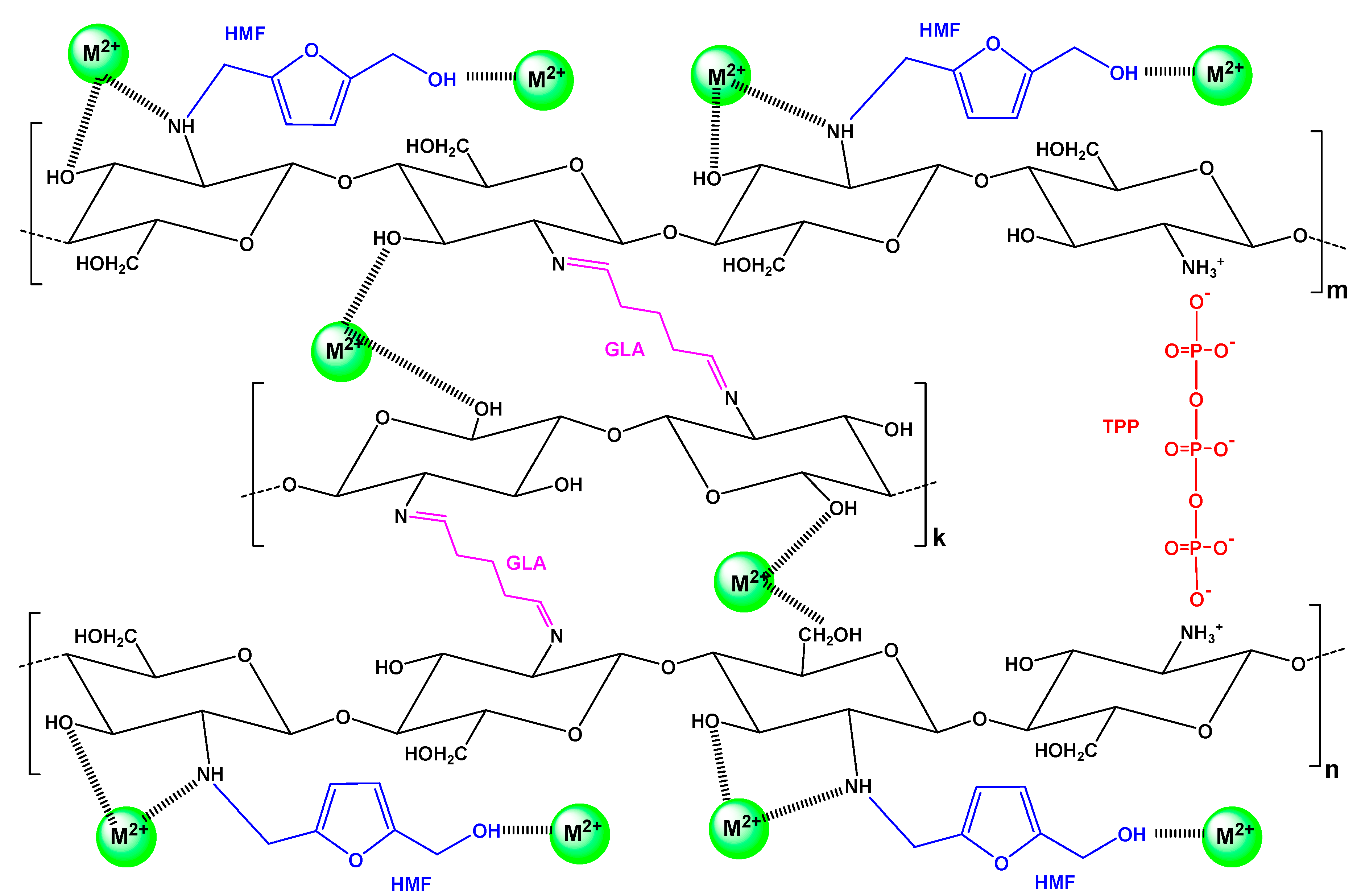
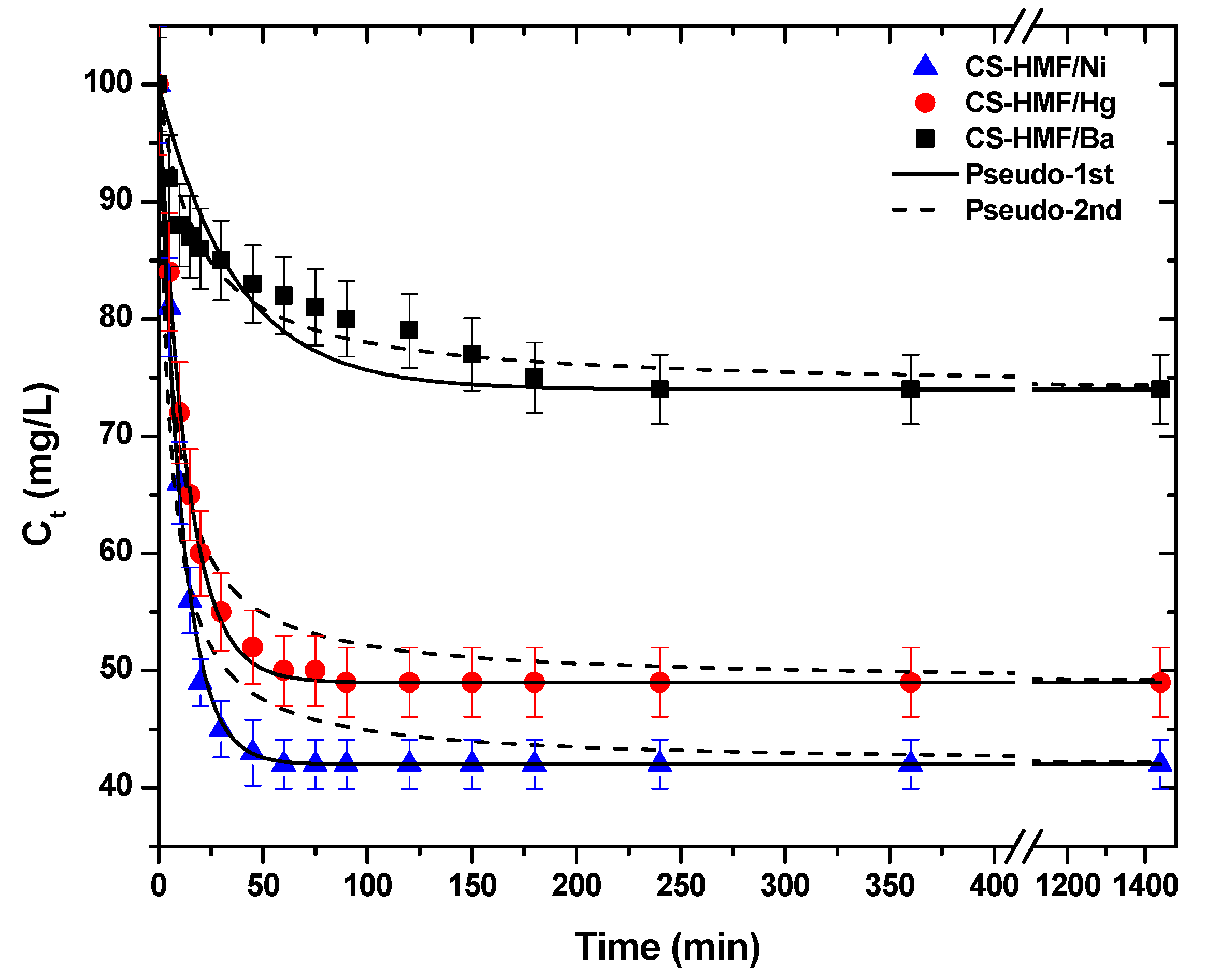

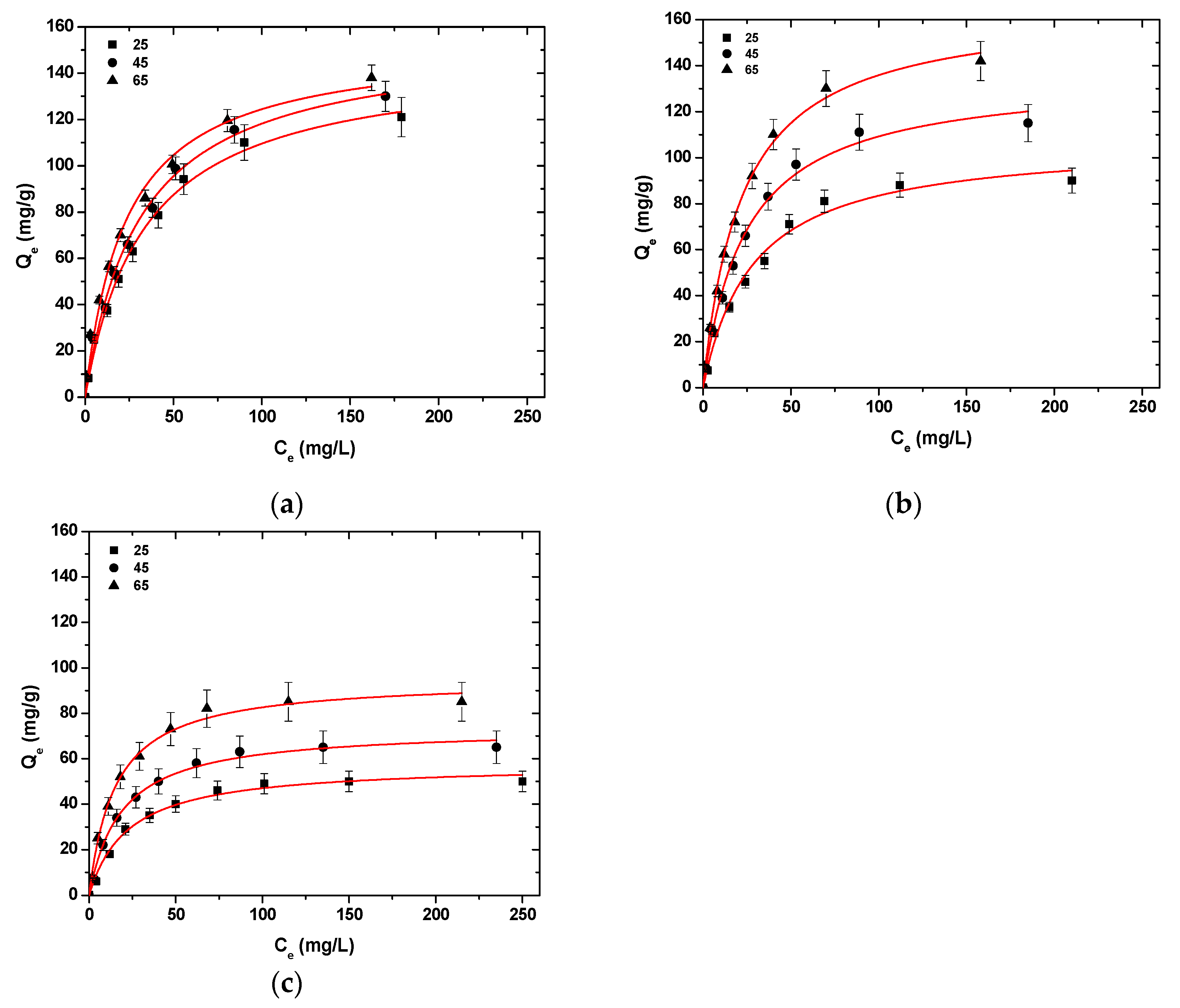

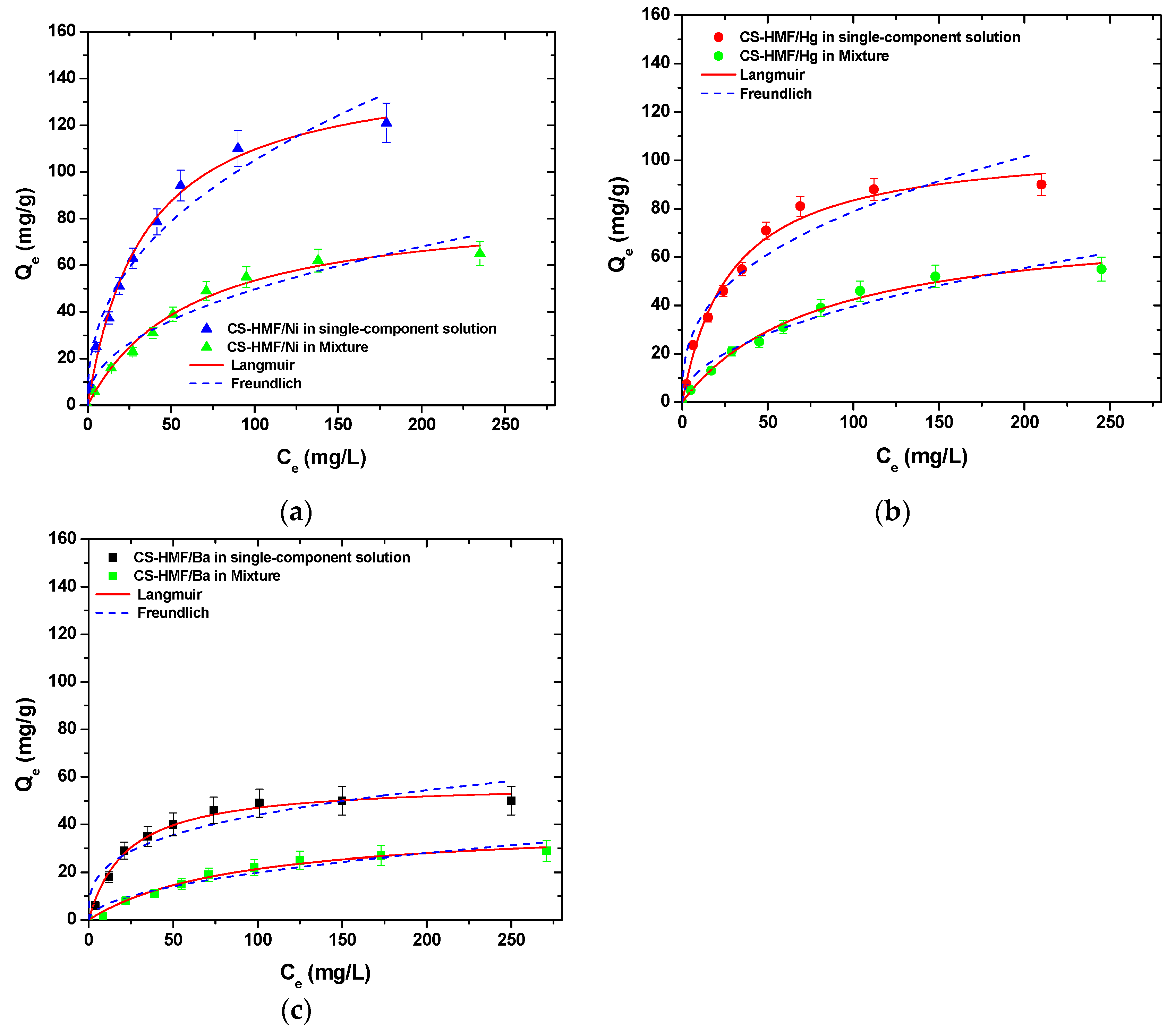
| Pseudo-1st Order | Pseudo-2nd Order | |||
|---|---|---|---|---|
| k1 | R2 | k2 | R2 | |
| Adsorbent | (min−1) | (g mg−1 min−1) | ||
| CS-HMF/Ni | 0.09184 | 0.997 | 0.19013 | 0.943 |
| CS-HMF/Hg | 0.07621 | 0.998 | 0.15267 | 0.963 |
| CS-HMF/Ba | 0.02768 | 0.817 | 0.05541 | 0.951 |
| Model | Equation | Parameter | Ni2 | Hg2 | Ba2+ |
|---|---|---|---|---|---|
| Langmuir | Qm (mg/g) | 147 | 107 | 64 | |
| KL (L/mg) | 0.029 | 0.035 | 0.034 | ||
| R2 | 0.994 | 0.988 | 0.991 | ||
| Freundlich | KF (mg1 − 1/n L1/n g−1) | 15.549 | 14.618 | 9.22 | |
| n (−) | 2.411 | 2.733 | 2.864 | ||
| R2 (−) | 0.959 | 0.928 | 0.95 |
| Ni2 | Hg2 | Ba2+ | ||||||||
|---|---|---|---|---|---|---|---|---|---|---|
| Model | T (°C) | 25 | 45 | 65 | 25 | 45 | 65 | 25 | 45 | 65 |
| Langmuir | Qm (mg/g) | 147 | 155 | 153 | 107 | 136 | 166 | 64 | 74 | 95 |
| KL (L/mg) | 0.029 | 0.032 | 0.043 | 0.035 | 0.040 | 0.045 | 0.034 | 0.053 | 0.066 | |
| R2 | 0.994 | 0.994 | 0.991 | 0.988 | 0.994 | 0.997 | 0.991 | 0.994 | 0.994 | |
| Dpw (m2/s) | |||
|---|---|---|---|
| Ion | 25 | 45 | 65 |
| Ni2+ | 5.45 × 10−9 | 8.72 × 10−9 | 12.52 × 10−9 |
| Hg2+ | 3.45 × 10−9 | 5.53 × 10−9 | 8.12 × 10−9 |
| Ba2+ | 1.89 × 10−9 | 3.04 × 10−9 | 4.47 × 10−9 |
| C0 | T | Kc | ΔG0 | ΔH0 | ΔS0 | |
|---|---|---|---|---|---|---|
| (mg/L) | (K) | (kJ/mol) | (kJ/mol) | (kJ/mol K) | ||
| CS-HMF/Ni | 10 | 298 | 4.56 | −3.76 | ||
| 318 | 5.67 | −4.59 | 14.13 | 0.060 | ||
| 338 | 9 | −6.18 | ||||
| 50 | 298 | 2.97 | −2.70 | |||
| 318 | 3.35 | −3.19 | 11.78 | 0.048 | ||
| 338 | 5.25 | −4.66 | ||||
| 120 | 298 | 1.90 | −1.59 | |||
| 318 | 2.14 | −2.01 | 5.98 | 0.025 | ||
| 338 | 2.53 | −2.61 | ||||
| 200 | 298 | 1.22 | −0.50 | |||
| 318 | 1.37 | −0.83 | 4.07 | 0.015 | ||
| 338 | 1.48 | −1.11 | ||||
| CS-HMF/Hg | 10 | 298 | 2.85 | −2.59 | ||
| 318 | 5.67 | −4.59 | 26.55 | 0.098 | ||
| 338 | 10.11 | −6.50 | ||||
| 50 | 298 | 2.33 | −2.10 | |||
| 318 | 3.55 | −3.35 | 16.97 | 0.064 | ||
| 338 | 5.25 | −4.66 | ||||
| 120 | 298 | 1.45 | −0.92 | |||
| 318 | 2.24 | −2.14 | 17.14 | 0.061 | ||
| 338 | 3.29 | −3.34 | ||||
| 200 | 298 | 0.79 | 0.60 | |||
| 318 | 1.25 | −0.58 | 18.01 | 0.058 | ||
| 338 | 1.86 | −1.74 | ||||
| CS-HMF/Ba | 10 | 298 | 1.50 | −1.00 | ||
| 318 | 2.33 | −2.24 | 20.74 | 0.072 | ||
| 338 | 4.00 | −3.90 | ||||
| 50 | 298 | 1.38 | −0.80 | |||
| 318 | 2.13 | −1.99 | 19.68 | 0.069 | ||
| 338 | 3.55 | −3.56 | ||||
| 120 | 298 | 0.62 | 1.18 | |||
| 318 | 0.94 | 0.18 | 19.11 | 0.060 | ||
| 338 | 1.55 | −1.24 | ||||
| 200 | 298 | 0.33 | 2.72 | |||
| 318 | 0.48 | 1.93 | 16.62 | 0.047 | ||
| 338 | 0.74 | 0.85 |
| Ni2 | Hg2 | Ba2+ | ||||||
|---|---|---|---|---|---|---|---|---|
| Model | Parameters | Single | Mix | Single | Mix | Single | Mix | Total |
| Langmuir | Qm (mg/g) | 147 | 87 | 107 | 76 | 64 | 41 | 204 |
| KL (L/mg) | 0.029 | 0.016 | 0.035 | 0.012 | 0.034 | 0.011 | 0.004 | |
| R2 | 0.994 | 0.989 | 0.988 | 0.991 | 0.991 | 0.987 | 0.992 | |
| Freundlich | KF (mg1 − 1/n L1/n g−1) | 15.549 | 6.194 | 14.618 | 4.221 | 9.22 | 2.053 | 6.827 |
| n | 2.411 | 2.211 | 2.733 | 2.056 | 2.864 | 2.027 | 2.071 | |
| R2 | 0.959 | 0.948 | 0.928 | 0.964 | 0.95 | 0.943 | 0.954 | |
| Adsorbent | Metal Ion | Qm(mg/g) | Reference |
|---|---|---|---|
| Porous thiourea-grafted-CS hydrogels | Ni2+ | 132.5 | [62] |
| CS coated polyvinyl chloride beads | 120.5 | [53] | |
| Magnetic activated carbon/CS beads | 108.7 | [63] | |
| DTPA-modified CS/polyethylene oxide nanofibers | 56 | [64] | |
| CS/magnetite composite beads | 52.55 | [12] | |
| Modified magnetic CS chelating resin | 40.15 | [7] | |
| Chemically cross-linked metal complexed CS | 37.88 | [65] | |
| Ethylenediaminetetraacetic acid-CS | 24.35 | [66] | |
| Diethylenetriaminepentaacetic acid -CS | 24.16 | [66] | |
| Thiourea-modified magnetic CS microspheres | 15.3 | [16] | |
| CS-MAA nanoparticles | 0.87 | [67] | |
| CS-HMF | 147 | This study | |
| Cross-linked magnetic CS-phenylthiourea resin | Hg2+ | 135 | [68] |
| Formaldehyde modified CS-thioglyceraldehyde | 98 | [69] | |
| Thiocarbohydrazide-chitosan | 52.63 | [70] | |
| CS | 24 | [71] | |
| CS-HMF | 107 | This study | |
| Weathered basalt/CS | Ba2+ | 45.78 | [52] |
| Dolomite powder | 3.96 | [72] | |
| Perlite | 2.49 | [13] | |
| CS-HMF | 64 | This study |
Publisher’s Note: MDPI stays neutral with regard to jurisdictional claims in published maps and institutional affiliations. |
© 2021 by the authors. Licensee MDPI, Basel, Switzerland. This article is an open access article distributed under the terms and conditions of the Creative Commons Attribution (CC BY) license (http://creativecommons.org/licenses/by/4.0/).
Share and Cite
Liakos, E.V.; Mone, M.; Lambropoulou, D.A.; Bikiaris, D.N.; Kyzas, G.Z. Adsorption Evaluation for the Removal of Nickel, Mercury, and Barium Ions from Single-Component and Mixtures of Aqueous Solutions by Using an Optimized Biobased Chitosan Derivative. Polymers 2021, 13, 232. https://doi.org/10.3390/polym13020232
Liakos EV, Mone M, Lambropoulou DA, Bikiaris DN, Kyzas GZ. Adsorption Evaluation for the Removal of Nickel, Mercury, and Barium Ions from Single-Component and Mixtures of Aqueous Solutions by Using an Optimized Biobased Chitosan Derivative. Polymers. 2021; 13(2):232. https://doi.org/10.3390/polym13020232
Chicago/Turabian StyleLiakos, Efstathios V., Mariza Mone, Dimitra A. Lambropoulou, Dimitrios N. Bikiaris, and George Z. Kyzas. 2021. "Adsorption Evaluation for the Removal of Nickel, Mercury, and Barium Ions from Single-Component and Mixtures of Aqueous Solutions by Using an Optimized Biobased Chitosan Derivative" Polymers 13, no. 2: 232. https://doi.org/10.3390/polym13020232
APA StyleLiakos, E. V., Mone, M., Lambropoulou, D. A., Bikiaris, D. N., & Kyzas, G. Z. (2021). Adsorption Evaluation for the Removal of Nickel, Mercury, and Barium Ions from Single-Component and Mixtures of Aqueous Solutions by Using an Optimized Biobased Chitosan Derivative. Polymers, 13(2), 232. https://doi.org/10.3390/polym13020232







